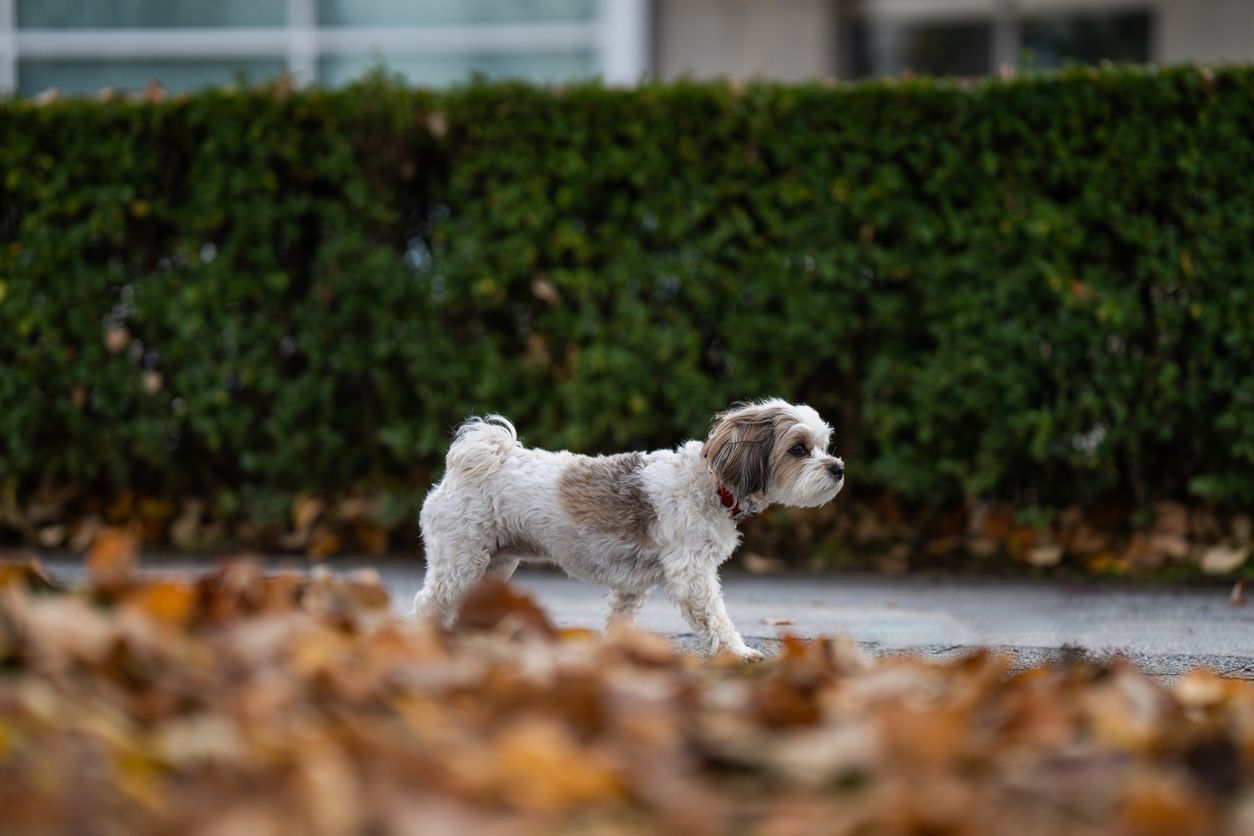How to prevent dental disease in dogs with proper dental care

Dental disorders, such as periodontal disease, are common in pet dogs. These dental issues can lead not only to bad breath and unsightly teeth but also serious health consequences as well. Preventing dental disease is important for the health and well-being of your dog. Read on if you’ve ever wondered:
- What causes dental disease in dogs?
- How can I prevent dental issues in my dog?
- How do I know if my dog has poor oral health?
- How will a vet diagnose and treat my dog’s dental disease?
Providing dental chews and treats is not enough to prevent dental disease in dogs. Regular toothbrushing and routine dental cleanings with a veterinarian are essential to providing the best oral care and helping prevent the many issues caused by dental disease.
What is canine dental disease?
Canine dental disease refers to a variety of disorders affecting the mouth, teeth, gums, and tooth-support structure in dogs. Different types of dental diseases are categorized based on their location in the mouth and their underlying causes, including:
Location of the dental disease
- Gingivitis - inflammation of the gums
- Periodontal disease - inflammation of the tooth-supportive structures
- Endodontic disease - disease affecting the interior of the tooth
Causes of the dental disease
- Poor oral hygiene
- Genetics
- Injury
- Infections
- Oral tumors
Developmental abnormalities such as tooth overcrowding, overbite, underbite, or unerupted teeth can also occur, especially in small or flat-faced breeds. Gum diseases, such as gingivitis and periodontal disease, are the most common types of dental disease in dogs.
Why is dental disease in dogs so dangerous?
Poor dental health can cause oral pain, affecting your dog’s quality of life. In addition, dental disease can contribute to a number of health issues, such as:
- Kidney disease
- Liver disease
- Bacterial infections
- Lowered life expectancy
Many dogs behave completely normally even when suffering from severe dental disease. Regular dental examinations with a veterinarian help catch dental problems before they progress to the point of endangering a dog’s overall health.
How can I prevent dental disease in my dog?
You can help prevent poor dental health in your dog by providing at-home oral care and regularly visiting a veterinarian.
Regular brushing at home
Gum disease is the most common dental issue affecting dogs. As daily plaque accumulates on the teeth, gum tissue becomes inflamed, which is a condition referred to as gingivitis, and leads to periodontal disease. Daily brushing removes the buildup of plaque, preventing the onset of gum disease. Daily toothbrushing is best, but brushing every few days still helps to remove plaque before it can harden into tartar on the tooth surface.
To brush a dog’s teeth, use a dog toothbrush, soft human toothbrush, finger toothbrush, or a damp washcloth to make circular motions on a dog’s teeth all the way to the gumline. Focus on the places where plaque most commonly accumulates: on the outer sides of the teeth, near the inside of the lips. Tasty treats, pet toothpaste, and praise can help with the process of brushing and even make the routine fun for dogs. Toothpaste is not necessary for brushing, but if you decide to use toothpaste, never use human toothpaste, as your dog will swallow it while you’re brushing their teeth. Human toothpaste causes stomach upset in dogs when swallowed, and it may contain xylitol, an ingredient toxic to dogs.
Professional dental cleanings and checkups
When your dog is young, dental checkups can help catch developmental forms of dental disease such as unerupted teeth, improper bite, and enamel defects. Developmental defects can cause painful dentigerous cysts and difficulty eating and can also lead to other forms of dental disease in the future. As a dog grows older, regular exams and dental cleanings both treat existing gum disease and prevent gum disease from becoming worse in the future.
Dental chews, food, chew toys, and other products
Some dental products can help slow the accumulation of plaque or help remove plaque from your dog’s teeth. When buying dental products, look for those with a Veterinary Oral Health Council (VOHC) seal to ensure they are effective. Dental diets, treats, toys, and other products are meant to be used along with brushing between professional cleanings and are not replacements for daily toothbrushing at home.
Be careful with hard treats, toys labeled “indestructible,” and tennis balls. While they may help scrape some plaque from your dog’s teeth, aggressive chewing on tennis balls, hard toys, bones, and antlers can wear down tooth enamel or cause fractured teeth.
What are the symptoms of poor oral health in dogs?
The most common and obvious symptoms of poor dental health in dogs are bad breath and yellow or brown tartar buildup on the teeth. Chronic bad breath and discolored teeth are never normal in dogs. Other symptoms of oral health issues may include:
- Red, inflamed, or bleeding gums
- Tooth loss, broken teeth, or loose teeth
- Favoring one side of the mouth
- Excessive drooling
- Blood in the mouth or saliva
- Difficulty eating or loss of appetite
Most dogs will not refuse a meal even when suffering from severe dental issues. It’s common for pet parents to assume their dog’s dental health is fine because they are eating normally, but poor dental health rarely interferes with a dog’s appetite or ability to eat. Look for more common symptoms such as bad breath and yellow or brown teeth.
How is canine dental disease diagnosed and treated?
The diagnosis of dental disease in dogs involves an oral examination and dental X-rays. Exams and X-rays while under anesthesia allow a veterinarian to thoroughly examine each tooth as well as view the roots and structure of the teeth below the gumline. The treatment for dental disease varies based on the type, location, and severity of the condition. Treatment options may include:
- Professional teeth cleaning and polishing
- Tooth extraction
- Oral surgery
- Root canals or other procedures, usually performed by a dental specialist
Board-certified veterinary dentists are trained in more complex procedures such as root canals and can be an option for some dental issues that affect dogs. Talk to a veterinarian to learn more about what treatment options are available for your dog.
Is anesthesia safe for my dog?
Dental procedures, including routine cleanings, require the use of anesthesia. “Even though anesthesia can be scary for pet owners, it’s never a good idea to delay a dental procedure,” explains Dr. Jo Myers, a Vetster veterinarian. “Doing so only allows the dental disease to progress and negatively impact the dog’s health. Anesthetic risk depends primarily on age, overall health, and the length of the procedure, so it usually goes up the longer you wait.” More frequent, shorter routine cleanings are safer than an invasive procedure that requires the prolonged use of anesthesia. While there are risks associated with using anesthesia, those risks are minimized with:
- Pre-anesthetic blood work and a thorough physical exam
- Close monitoring while under and waking from anesthesia
- Heated blankets or other devices to safely keep your dog warm throughout the procedure
- IV catheter placement for fluids and medications
Dogs do not understand why they are having their teeth cleaned or examined and are usually unwilling to tolerate dental work without the aid of anesthesia. In addition, sharp dental instruments can be dangerous if a dog is moving around during the procedure. Anesthesia is also necessary for a veterinarian to thoroughly examine and clean every tooth and remove plaque buildup below the gumline. Overall, the health risks posed by advanced dental disease far outweigh the risks of anesthesia.
Why is preventing dental disease in dogs important?
Dental disease prevention is easier, safer, and cheaper than treating it. Periodontal disease and other dental issues can risk the health and well-being of dogs by contributing to life-threatening conditions, causing pain, decreasing a dog’s overall quality of life, and even decreasing their life span.
Gingivitis and periodontal disease are extremely common in dogs, affecting 80% of dogs by the age of two. At-home prevention with the use of regular brushing and VOHC-approved products helps maintain oral health between professional cleanings with a veterinarian. You can book a virtual vet appointment with a Vetster veterinarian to establish a prevention plan for your dog’s dental health.
FAQ - How to prevent dental disease in dogs with proper dental care
How can I prevent my dog from getting dental disease?
Daily toothbrushing at home and visiting a veterinarian for dental checkups and routine cleanings are the best ways to prevent a dog from getting dental disease. Even dogs who have their teeth brushed regularly benefit from professional cleanings done by a vet.
Can periodontal disease be prevented in dogs?
Periodontal disease is a severe form of gum disease that is very common in dogs. Dog owners can help prevent it with daily toothbrushing at home in between routine dental examinations and cleanings.
How can I improve my dog’s dental hygiene?
Following an at-home toothbrushing routine is one of the best ways to improve your dog’s dental hygiene. Before you start, talk to a vet to ensure your dog does not have inflamed gums or tartar buildup. Brushing won’t remove tartar, and gum inflammation can make toothbrushing painful for your dog, resulting in a negative association with the process.
Can I prevent my dog’s bad breath?
Bad breath is often the first sign of dental disease in dogs. Dental care at home and provided by a vet help prevent the onset of dental disease and help treat existing dental issues. Many dental products that claim to freshen breath, such as water additives, only cover up the problem without solving the underlying issue.




